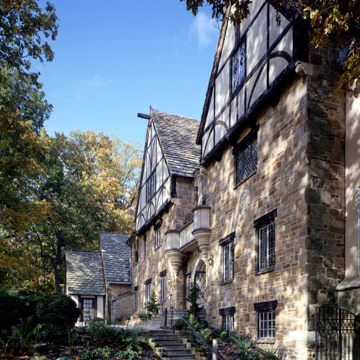Wealthy Baltimoreans Sumner and Dudrea Parker traveled extensively during the 1910s and 1920s, collecting medieval objects, art, and architectural fragments to be incorporated into their future country house. The Parkers’ city house was in the Mount Vernon neighborhood and inadequate to display the many collections that they stored in a warehouse after each trip. Sumner Parker was trained as an architect and engineer and for many decades served as president of Armstrong and Parker Co., a prominent Baltimore architectural ironwork firm responsible for ornamental balconies, fences, and gates throughout the city. He designed the house himself, incorporating steel beams and modern amenities into a fanciful medieval mode house. The steel beams helped support the weight of an unusual flagstone roof on exterior walls of rusticated Butler stone, a granite-like local stone prized for its unusual grey coloring with flecks of gold from quartz, mica, and other minerals.
In 1930 the Parkers began construction of their long-planned retreat on an approximately fifty-five-acre hilly and wooded parcel. The main elevation faces south and features two massive half-timbered gables acquired in France that dominate a not quite symmetrical composition. The rest of the exterior is a rich variety of forms and materials, with crenellated parapets, gargoyles, molded chimney caps, and diamond pane iron casement windows of varied shape and size. A one-story octagonal chapel structure extends from the house’s west side, and a massive octagonal stair tower appears on the rear at the cloistered terrace.
The interior is packed with even more medieval decorative detail such as carved woodwork, plaster ceilings designed to resemble Gothic stone ribbed vaulting, and ornamental ironwork. Parker designed and his firm fabricated the four-story spiral stair railing at the center of the house, the library staircase bannister, and window grilles and balconies. Many of the interior doors and mantels are fifteenth- and sixteenth-century pieces collected by the Parkers in France and Italy. The Parkers also used windows, doors, and other features they salvaged from Glen Ellen, the Baltimore area’s earliest Gothic Revival house designed by Ithiel Town and Alexander Jackson Davis in 1832 and demolished in 1929–1930.
Several rooms housed specialized collections the Parkers displayed to the public. On the first floor the library exhibited rare manuscripts among the exposed wood ceiling trusses and tall bookcases, and tapestries and paintings were displayed in the gallery, a tall, spacious room with heavy carved ceiling beams. Upstairs rooms were dedicated to dolls and dollhouses, and Dudrea Parker’s family heirloom American colonial furniture and objects. Sumner Parker died in 1945 and Dudrea Parker willed the house and its contents to the City of Baltimore upon her death in 1972. It is currently an event venue managed by the Baltimore Office of Promotion and the Arts. Although a rare and eccentric accomplishment, the Cloisters speaks to the early-twentieth-century interest in handicraft and architectural authenticity popularized by the Arts and Crafts movement and the 1920s fashion for revival architecture, most commonly seen in movie palaces and luxury hotels, that created fantasy stage settings invoking a romantic past.


